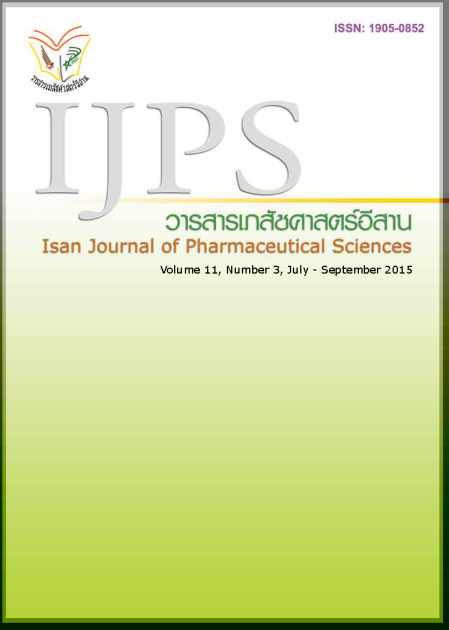ความถี่ของยีน KIR2DS3 ในประชากรชาวไทย
Main Article Content
บทคัดย่อ
บทนำ: KIR2DS3 เป็นยีนที่ทำหน้าที่สร้างโปรตีน KIR2DS3 (หรือที่รู้จักในนาม NKAT7) ซึ่งอยู่บนผิวของ natural killer (NK) cell และมีบทบาทเกี่ยวกับการตอบสนองทางภูมิคุ้มกันยีนนี้มีภาวะพหุสัณฐานสูงและพบความถี่ของยีนได้แตกต่างกันมากในแต่ละกลุ่มประชากรนอกจากนี้พบว่ายีน KIR2DS3 มีความสัมพันธ์กับโรคติดเชื้อหลายชนิด อาทิ การติดเชื้อไวรัสตับอักเสบซี การติดเชื้ออีโบลา มาลาเรีย และวัณโรค วัตถุประสงค์ของงานวิจัยนี้คือ เพื่อศึกษาความถี่ของยีน KIR2DS3 ในประชากรชาวไทยและการกระจายความถี่ของยีนนี้ในแต่ละภูมิภาคของประเทศไทย วิธีการดำเนินการวิจัย: ทำการสุ่มอาสาสมัครสุขภาพดีที่ไม่มีความสัมพันธ์กันทางเครือญาติ จำนวน 100 รายจากสี่ภูมิภาคเท่าๆ กัน (ภูมิภาคละ 25 ราย) ตามภูมิลำเนาซึ่งแบ่งโดยกรมการปกครองกระทรวงมหาดไทยจากนั้นทำการเจาะเลือดอาสาสมัครเพื่อสกัดดีเอ็นเอด้วยวิธี Chelex method และทำการเพิ่มปริมาณดีเอ็นเอและตรวจวิเคราะห์หายีน KIR2DS3 ด้วยเทคนิคปฏิกิริยาลูกโซ่โพลีเมอเรสโดยอาศัยไพรเมอร์จับจำเพาะ ผลการวิจัย: พบยีน KIR2DS3 ในอาสาสมัครจำนวน 42 รายจากอาสาสมัครทั้งหมด 100 รายคิดเป็น 42% โดยพบการกระจายความถี่ของยีนในอาสาสมัครแต่ละภูมิภาคดังนี้ ภาคเหนือพบ 44% (11 รายจาก 25 ราย) ภาคกลางพบ 72% (18 รายจาก 25 ราย) ภาคตะวันออกเฉียงเหนือพบ 20% (5 รายจาก25 ราย) และภาคใต้พบ 32% (8 รายจาก 25 ราย) สรุปผลการวิจัย: ในประชากรชาวไทยสามารถพบภาวะพหุสัณฐานของยีน KIR2DS3 ได้ และความถี่ที่พบของยีนนี้จะแตกต่างกันตามภูมิภาคของประเทศโดยประชากรในภาคตะวันออกเฉียงเหนือจะพบยีนนี้ได้น้อยที่สุดเมื่อเทียบกับภูมิภาคอื่นของประเทศดังนั้นข้อมูลเหล่านี้จะเป็นประโยชน์ในอนาคตต่อการศึกษาความสัมพันธ์ของยีน KIR2DS3 กับการเกิดโรคต่างๆ ในประชากรชาวไทย
Article Details
กรณีที่ใช้บางส่วนจากผลงานของผู้อื่น ผู้นิพนธ์ต้อง ยืนยันว่าได้รับการอนุญาต (permission) ให้ใช้ผลงานบางส่วนจากผู้นิพนธ์ต้นฉบับ (Original author) เรียบร้อยแล้ว และต้องแนบเอกสารหลักฐาน ว่าได้รับการอนุญาต (permission) ประกอบมาด้วย
References
Campbell KS and Purdy AK. Structure/function of human killer cell immunoglobulin-like receptors: lessons from polymorphisms, evolution, crystal structures and mutations. Immunology 2011; 132: 315–325.
Carrington M and Norman P. The KIR Gene Cluster. Bethesda (MD): National Center for Biotechnology Information (US); 2003.
Chaisri S, Kitcharoen K, Romphruk AV, et al. Polymorphisms of killer immunoglobulin-like receptors (KIRs) and HLA ligands in northeastern Thais. Immunogenetics 2013; 65(9): 645-653.
Dring MM, Morrison MH, McSharry BP, et al. Innate immune genes synergize to predict increased risk of chronic disease in hepatitis C virus infection. Proc Natl Acazd Sci 2011; 108(14): 5736-5741.
Hollenbach JA, Nocedal I, Ladner MB, et al. Killer cell immunoglobulin-like receptor (KIR) gene content variation in the HGDP-CEPH populations. Immunogenetics 2012; 64(10): 719-737.
The Allele Frequency Net Database.[Online]. Sep 2007 [cited 2015 July 20]. Available from: http://www.allelefrequencies.net/
Jiang K, Zhu FM, Lv QF, Yan LX. Distribution of killer cell immunoglobulin-like receptor genes in the Chinese Han population. Tissue Antigens 2005; 65(6):556-563.
Keane C, O’Shea D, Reiberger T, et al. Variation in both IL28B and KIR2DS3 genes influence pegylated interferon and ribavirin hepatitis C treatment outcome in HIV-1 co-infection. PLoS One 2013; 8(6): e66831.
Lee YC, Chan SH, Ren EC. Asian population frequencies and haplotype distribution of killer cell mmunoglobulin-like receptor (KIR) genes among Chinese, Malay, and Indian in Singapore. Immunogenetics
; 60(11): 645-654.
Lu C, Shen YJ, Deng YF, et al. Association of killer cell immunoglobulin-like receptors with pulmonary tuberculosis in Chinese Han. Genet Mol Res 2012; 11(2): 1370-1378.
Marsh SG, Parham P, Dupont B, et al. Killer-cell immunoglobulin-like receptor (KIR) nomenclature report, 2002. Immunogenetics 2003; 55: 220–226.
Norman PJ, Carrington CV, Byng M, et al. Natural killer cell immunoglobulin-like receptor (KIR) locus profi les in African and South Asian populations. Genes Immun 2002; 3(2): 86-95.
Nakimuli A, Chazara O, Farrell L, et al. Killer cell immunoglobulin-like receptor (KIR) genes and their HLA-C ligands in a Ugandan population. Immunogenetics 2013; 65(11): 765-775.
Norman PJ, Stephens HA, Verity DH, et al. Distribution of natural killer cell immunoglobulin-like receptor sequences in three ethnic groups. Immunogenetics 2001;52(3-4): 195-205.
NurWaliyuddin HZ, Edinur HA, Norazmi MN, et al. Killer immunoglobulin-like receptor diversity in Malay subethnic groups of Peninsular Malaysia. Int J Immunogenet 2014; 41(6): 472-479.
Olaniyan SA, Amodu OK, Yindom LM, et al. Killer-cell immunoglobulin-like receptors and falciparum malaria in southwest Nigeria. Hum Immunol 2014; 75(8): 816-821.
Rajalingam R, Krausa P, Shilling HG, et al. Distinctive KIR and HLA diversity in a panel of north Indian Hindus. Immunogenetics 2002;53(12): 1009-1019.
Single RM, Martin MP, Meyer D, et al. Methods for assessing gene content diversity of KIR with examples from a global set of populations. Immunogenetics. 2008;60 (12): 711-725.
Tammakorn C, Mongkolsuk T, Thammanichanond D, et al. Distribution of killer cell immunoglobulin-like receptor genes in Thai blood donors. J Med Assoc Thai 2011; 94(6): 738-742.
Uhrberg M, Parham P, Wernet P. Defi nition of gene content for nine common group B haplotypes of the Caucasoid population: KIR haplotypes contain between seven and eleven KIR genes. Immunogenetics
; 54(4): 221-229.
VandenBussche CJ, Mulrooney TJ, Frazier WR, et al. Dramatically reduced surface expression of NK cell receptor KIR2DS3 is attributed to multiple residues throughout the molecule. Genes Immun 2009;10(2):
-173.
Velickovic M, Velickovic Z, Panigoro R, et al. Diversity of killer cell immunoglobulin-like receptor genes in Indonesian populations of Java, Kalimantan, Timor and Irian Jaya. Tissue Antigens. 2009; 73(1): 9-16.
Vilches C and Parham P. KIR: diverse, rapidly evolving receptors of innate and adaptive immunity. Annu Rev Immunol 2002; 20: 217–251.
Vilches C, Castaño J, Gómez-Lozano N, Estefanía E. Facilitation of KIR genotyping by a PCR-SSP method that amplifi es short DNA fragments. Tissue Antigens 2007; 70(5): 415-422.
Wauquier N, Padilla C, Becquart P, et al. Association of KIR2DS1 and KIR2DS3 with fatal outcome in Ebola virus infection. Immunogenetics 2010; 62: 767-771.
Whang DH, Park H, Yoon JA, Park MH. Haplotype analysis of killer cell immunoglobulin-like receptor genes in 77 Korean families. Hum Immunol 2005; 66(2): 146-154.
Yawata M, Yawata N, McQueen KL, et al. Predominance of group A KIR Haplotypes in Japanese associated with diverse NK cell repertoires of KIR expression. Immunogenetics 2002; 54(8): 543-550.

